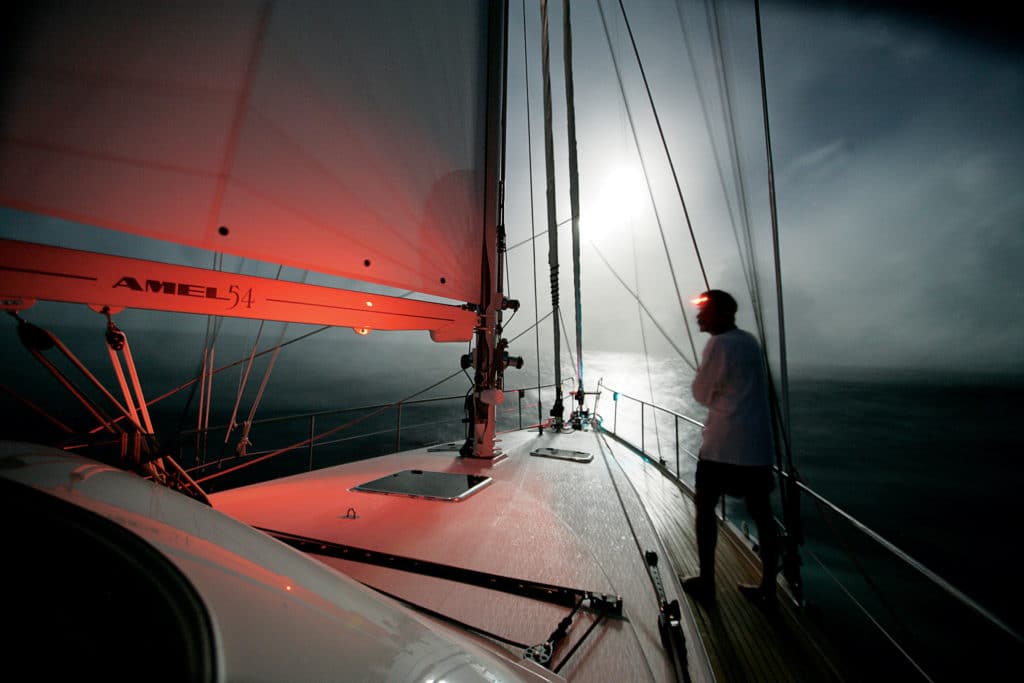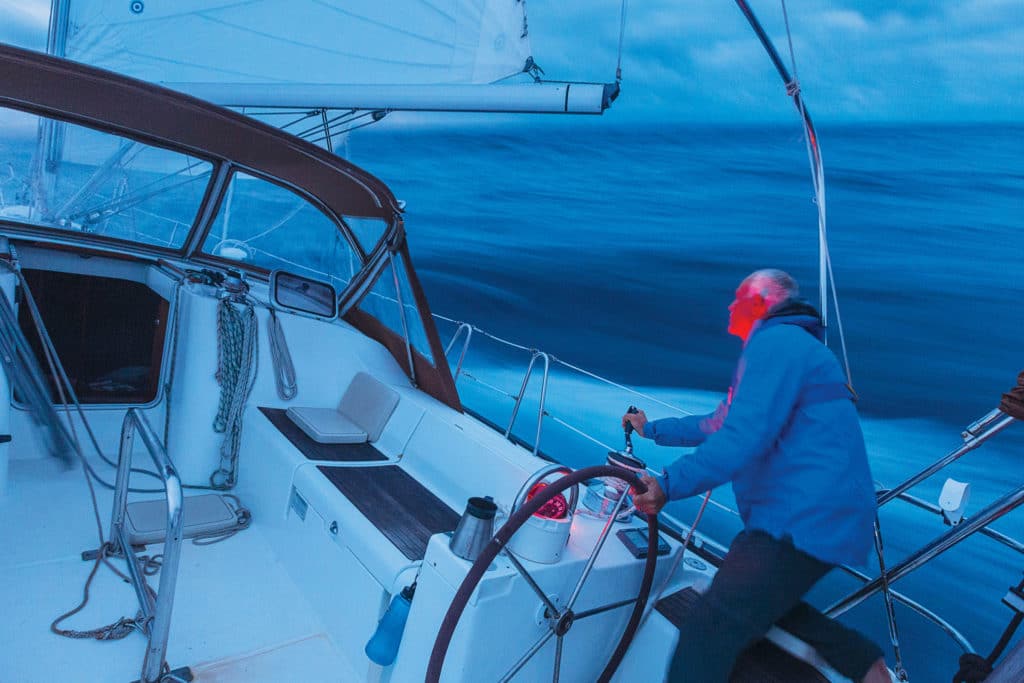The sun is just about to touch the horizon and you’ve spent the last hour setting up extra safety precautions for night sailing. You’ve connected a strobe light to your MOB ring. Every crew member on deck is wearing a harness and PFD with a light and whistle. And you’re showing the proper navigation lights to comply with the rules of the road. Every chart you’ll need this evening has been pulled from the locker, your course is plotted and lights you’ll see along the way have been listed. With your hand bearing compass and parallel rules, now you’re prepared to navigate — but under the dark cloak of night, how will you see?
At night, when visibility is compromised, sailors rely on all their senses to understand where they are and how the boat is moving. While we tune in our ears to listen for bells, breaking waves and horns, we sometimes forget that with an understanding of our vision and how it works at night, we can use techniques to help us adapt to the dark and see more than we thought possible.
Developing Night Vision
When we step outside our door at night and gaze up at the sky, we first notice the brightest stars, but as our eyes adjust, we can see more of them. The typical person needs 12 to 40 minutes for their eyes to adapt and fully employ night vision. There are a few things you can do to decrease that time and maintain good vision throughout the night.
Preparing your eyes for night begins hours before the sun even touches the horizon. During the brightest part of the day, your eyes are overwhelmed with light. Start preparing early by wearing sunglasses and a sun hat all day. This will ease the transition into night and also protect your eyes from getting sunburned.
Exposure to light at night will interrupt your vision and require more time to readapt. Bright navigation instruments can be more than a nuisance for anyone serious about maintaining night vision. Be aware that frequent use of a chart plotter with a lit screen at night will impair your night vision, even on the dimmest setting. To best maintain night vision, first dim the lights on navigation instruments. Then turn off all the nonessential instruments. You can turn them on again in an urgent situation and they will already be programmed to a dim-light setting.
Your eyes adopt their night vision more quickly after exposure to red light instead of yellow or white. Use flashlights that have red bulbs in them. When you are using a spotlight to see shapes on the water, extend your arm outboard to prevent light shining on the boat or rig from reflecting back into your eyes.
Using Your Peripheral Vision
Knowledge of ships’ light patterns is essential during night travel. Still, a lot remains unlit and hard to find and identify. Take this scenario as an example: Off the starboard quarter, you notice a dark form. But when you stop scanning and look back in its general direction, you can no longer see it. It’s as if it was there and disappeared, and your eyes are playing tricks on you. This is a common mistake resulting from being unfamiliar with scanning techniques that utilize the features of your eyes.
When light enters the eye it passes through the cornea to the retina. The retina has cone cells at the center, surrounded by rod cells. Rods function in low light because they are much more sensitive to light than cones. Because of the rods’ location, they are also used for peripheral vision. Therefore, oddly enough, your peripheral vision is better suited for finding forms on the horizon at night. Train yourself to mentally focus a few degrees on the periphery while still looking ahead. It seems odd not to look directly at what you want to see, but with practice this technique becomes second nature.
Scanning the Horizon at Night
Without full understanding of the limitations of our eyes, scanning the horizon effectively can be impeded. Eyes have a difficult time focusing on objects when you’re in motion. Even though we often scan the horizon in a sweeping motion, it’s better to scan slower and stop at regular intervals along the way. Your eyes must move from point to point, stopping each time to focus.
Central vision is what we use to focus on reading, driving a car or seeing things directly in front of us. It only encompasses 3 to 15 degrees of the field of view, and is surrounded by the peripheral vision. For a thorough scan of the horizon, pause every 5 to 10 degrees so you don’t miss anything due to your narrow field of view.
One way to measure degrees is to use your body as a measuring tool. Raise your fist in front of you with an outstretched arm. The width of your fist is about 10 degrees. You can verify this by resting your vertical fist on the horizon and stacking one fist over another, hand over hand, counting each time. When you reach nine fists tall, theoretically it is 90 degrees, and you should be looking at a 90-degree angle from the horizon, or at your zenith.
Recognizing and Reducing Eye Fatigue
Standing night watches is a tiring job, and fatigue will affect your ability to spot objects in the dark. Your eyes work best when looking straight ahead. While scanning, keep your eyes fixed ahead and rotate your head instead. This will reduce fatigue. It will also provide the clearest view. Even if you don’t notice it, your nose blocks some of your vision when you look to the sides by turning your eyes instead of your head.
Have you ever noticed colorful blobs that start to dance through your vision if you stare at one place long enough? This is a sign of tired eyes. Keep moving your eyes regularly through your scanning pattern. Your eyes are working much harder when they’re stationary for long periods. They also strain when they’re trying to see things that are far away. One way to rest your eyes as you systematically scan the horizon is to stop occasionally and focus on a close object in the boat.
When you’re standing watch at night, the things you’re looking for are small and hard to see. A dim blinking light, a dark spot in the sky or a gray form in the distance could inform you of shoals, approaching storms or even land. As prudent sailors, we do everything we can to ensure we are prepared for any situation. All too often, eye care, scanning techniques and maintaining night vision are subjects that get pushed to the bottom of our list and designated as low priority. However, because of the inherent challenges that nightfall brings, it becomes even more important to prepare properly. Understanding the abilities and limitations of your eyes at night, and developing techniques that will help maximize what you can see, could be the difference between avoiding a dangerous situation or sailing straight into it.
Quick Guide to Night Vision
- Wear sunglasses and sun hat during the day.
- Use red light bulbs in flashlights and cabin lights at night.
- Dim screens on navigation instruments and turn off unnecessary electronics.
- Allow up to 40 minutes for your eyes to adapt to night vision before setting sail in the dark.
- Practice making conscious use of your peripheral vision.
- Allow a moment for your eyes to focus by scanning slowly and stopping every 5 to 10 degrees along the way.
- While scanning, keep your eyes facing forward and rotate your head instead.
- Keep moving your eyes regularly through your scanning pattern.
- Stop scanning occasionally to rest your eyes by focusing on a close object in the boat.
- Practice using techniques for scanning and maintain night vision every time you go outside at night.
This article first appeared in the July 2014 issue of Cruising World. Teresa Carey and her husband, Ben Eriksen, offer sail-training expeditions aboard their Norseman 447. For more information or to read other articles by Teresa, visit her website.

headlamp

instruments are set to dim or red lighting










